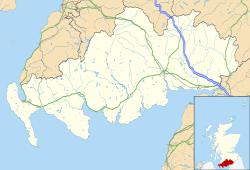Trusty's Hill facts for kids
| Location | near Gatehouse of Fleet, Dumfries and Galloway |
|---|---|
| Coordinates | 54°52′43.97″N 4°12′3.42″W / 54.8788806°N 4.2009500°W |
| OS grid reference | NX58895601 |
| Type | hillfort |
| Length | 29 m (95 ft) |
| Width | 17 m (56 ft) |
| Area | 0.04 ha (0.099 acres) (summit enclosure) |
| History | |
| Founded | c. 600 AD |
| Abandoned | early 7th century |
| Site notes | |
| Excavation dates | 1960, 2012 |
| Designated | 19 January 1926 |
| Reference no. | SM1100 |
Trusty's Hill is an ancient hillfort located in Scotland. It sits about a mile west of the town of Gatehouse of Fleet. This site is special because it's a vitrified fort. This means its stone walls were heated so intensely that they melted and fused together, making them extra strong.
What makes Trusty's Hill even more exciting is a unique carved stone found there. This stone has mysterious symbols made by the Picts, an ancient people of Scotland. It's one of the few Pictish stones found outside their main homeland in North-East Scotland. Recent digs have also uncovered clues about big feasts and fancy metalworking that happened here. There's even a special path that might have been used for important ceremonies. These discoveries suggest Trusty's Hill was a very important place, possibly a royal center for an ancient kingdom around 600 AD. Some experts think it might have been the lost kingdom of Rheged.
Contents
What is Trusty's Hill?
Trusty's Hill is a small, ancient fort built on a hill. It was constructed around 600 AD. The fort's walls were made using a special technique called vitrification. This process involved setting huge fires against the stone walls. The intense heat melted the stones, making them stick together like glass. This created a very strong and durable defense.
The fort was likely abandoned in the early 7th century. Today, it is a protected historical site. It helps us learn about life in Scotland over 1,400 years ago.
The Mysterious Pictish Stone
One of the most important finds at Trusty's Hill is a carved stone. This stone features symbols created by the Picts. The Picts were a group of people who lived in eastern and northern Scotland during the late Iron Age and early Medieval periods. Their symbols are often a mystery to us today.
The stone at Trusty's Hill shows several symbols:
- A double disc with a Z-rod
- A strange fish monster
- A sword
This stone is very rare because most Pictish stones are found much further north. Its presence here suggests that the Picts had some influence or connection to this area. It might have been a boundary marker or a sign of power.
Uncovering Ancient Secrets
Archaeologists have explored Trusty's Hill twice. The first excavation was in 1960. More recently, a major dig took place in 2012. These digs helped uncover many clues about the people who lived there.
The discoveries from the 2012 excavation were very exciting:
- Evidence of Feasting: They found animal bones and other signs of large gatherings. This suggests that important people held big feasts or parties at the fort.
- High-Status Metalworking: Archaeologists found tools and waste from making fancy metal objects. This means skilled craftspeople created valuable items, perhaps for the fort's rulers.
- A Ceremonial Path: They also found what looks like a special path leading to the fort. This "processional route" might have been used for important ceremonies or royal events.
These findings suggest that Trusty's Hill was more than just a fort. It was likely a very important center. It might have been a place where kings were crowned or important decisions were made.
The Kingdom of Rheged
The discoveries at Trusty's Hill have led to an interesting idea. Some historians believe the fort might have been a key location for an ancient kingdom. This kingdom was called Rheged. It was a Brythonic kingdom, meaning its people spoke an early form of Welsh. Rheged was located in what is now Galloway and South-West Scotland.
Rheged was most famous under its legendary leader, Urien. He lived in the late 6th century, around the same time Trusty's Hill was active. However, the kingdom of Rheged mysteriously disappeared in the early 7th century. Trusty's Hill could provide clues to understanding this lost kingdom. It helps us imagine what life was like for the powerful people who lived in this part of Scotland long ago.
Images for kids




